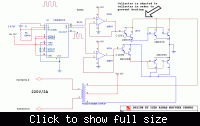Tahmid
Advanced Member level 6

- Joined
- Jun 17, 2008
- Messages
- 4,764
- Helped
- 1,799
- Reputation
- 3,590
- Reaction score
- 1,662
- Trophy points
- 1,413
- Location
- Berkeley, California
- Activity points
- 30,714
Yes. TL494 to drive the Push-Pull. KA3525 to drive the H-Bridge.i know the tl494 is running at very high frequencies,
can i use ka3525 ONLY TO SWITCH THE H-BRIDGE MOSFETS @60HZ IN Order to gain this frequency.
so to refresh i am using both ics TL494 AS THE MAIN IC TO GENERATE PWM
AND KA3525 JUST TO DRIVE THE H-BRIDGE
Using TL494 the circuit is running at high frequencies.Another way to look at it is,
THE CIRCUIT IS RUNNING AT HIGH FREQUENCIES..... USING TL494
HOW DO I GET 50HZ,
hope u undertand where i am going wrong
Using KA3525 to generate 50 Hz, you drive the bridge at 50Hz and so the bridge outputs an AC voltage with 50Hz frequency.
You also need to use a hi/lo side MOSFET driver for the H-bridge like IR2110/L6385. There are many others.




